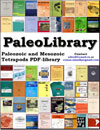
Complete Data Base of Paleozoic and Mesozoic Tetrapods.
Paleo-News and illustrations. Big electronic PDF-library.
| |
| PaleoNews |
| Classification |
| Books and Articles |
| Contact |
| Forum |
сайт о динозаврах
рейтинг сайтов
Free Counter
myspace hit counter
Outrageous heads led to outrageously large dinosaurs |
|
Tyrannosaurus rex and other large meat-eating theropods were the biggest baddies on the prehistoric block, and ornaments on their heads could help us figure out why. New research from North Carolina State University shows that theropod dinosaur species with bony crests, horns and knobs evolved to giant body sizes 20 times faster than those species lacking such embellishments. Additionally, the research shows that theropod dinosaurs most closely related to birds abandoned the hard ornaments strategy of their ancestors and likely used feathers for visual communication. Most large theropods – in fact 20 of the largest 22 species like T. rex and Allosaurus – have bony bumps or crests on their heads. Paleontologists hypothesize that the accoutrements served as socio-sexual display mechanisms – a way for the dinosaurs to signal to one another for mating, territory or defense purposes. Terry Gates, lecturer in NC State's Department of Biological Sciences and research adjunct at the North Carolina Museum of Natural Sciences, wondered if there was a correlation between the development of cranial ornamentation and rapid gains in size. Along with colleague Lindsay Zanno, also of NC State and the NC Museum of Natural Sciences, and Montana State University's Chris Organ, Gates examined the fossils of 111 ornamented and unornamented theropods and compared their size increases over time. Using observational data and computer modeling, the researchers found that for theropods weighing under 36 kg (about 80 pounds) bony cranial ornamentation did not evolve. Above that threshold, 20 of the 22 largest theropods had ornamentation. And it turns out that once a theropod species developed some style of head display, subsequent species would take large leaps toward gigantic body sizes every 4 to 6 million years. Large theropod lineages containing species without ornamentation – such as Acrocanthosaurus – did not achieve giantism as rapidly as their ornamented brethren. "We were surprised to find such a strong relationship between ornaments and huge body size in theropods," Gates explains. "Something about their world clearly favored bling and big bods." The researchers also looked at the lineage of dinosaurs that led to modern birds – including maniraptoriforms like Velociraptor, Ornithomimus and Falcarius. These dinosaurs never acquired bony head displays (except the parrot-like oviraptors) despite the fact that many of them weighed much more than the 36 kg threshold for gaining such ornamentation. This led the researchers to wonder why the closest relatives to birds were defying the pattern observed for other theropod dinosaurs. "The best explanation is that the long stiff feathers, which originated in this group of dinosaurs and were similar to modern bird feathers, could perform equally well as social signals when compared to the bony displays in T. rex or Dilophosaurus," Gates surmises. Zanno agrees. "Our work supports the idea that vaned feathers were great communication tools from the get-go and may have helped large bird-like theropods sidestep the bother of skeletal bells and whistles," she says. The research appears in Nature Communications. Explore further: For some feathered dinosaurs, bigger not necessarily better More information: "Bony cranial ornamentation linked to rapid evolution of gigantic theropod dinosaurs" Nature Communications, DOI: 10.1038/ncomms12931 http://phys.org/news/2016-09-outrageous-outrageously-large-dinosaurs.html
|
